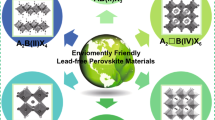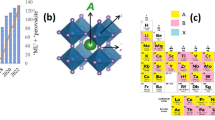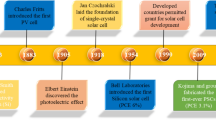Abstract
This work presents a machine learning approach to predict novel perovskite oxide materials in the Pr-Al-O and Pr-Sc-O compound families with the potential for photoluminescence applications. The predicted materials exhibit a large bandgap and high Debye temperature, and have remained unexplored thus far. The predicted compounds (Pr\(_3\)AlO\(_6\), Pr\(_4\)Al\(_2\)O\(_9\), Pr\(_3\)ScO\(_6\) and Pr\(_3\)Sc\(_5\)O\(_{12}\)) are screened using machine learning approach, which are then confirmed by density functional theory calculations. The study includes the calculation of the bandgap and density of states to determine electronic properties, and the optical absorption and emission spectra to determine optical properties. Mechanical stability of the predicted compounds, as demonstrated by satisfying the Born-Huang criterion. By combining machine learning and density functional theory, this work offers a more efficient and comprehensive approach to materials discovery and design.
Graphical Abstract










Similar content being viewed by others
Data availability
All data and code needed to produce the work are available from the corresponding author.
References
Fan Z, Sun K, Wang J (2015) Perovskites for photovoltaics: a combined review of organic-inorganic halide perovskites and ferroelectric oxide perovskites. J Mater Chem A 3:18809. https://doi.org/10.1039/C5TA04235F
Kim J, Lee S-H, Lee JH, Hong K-H (2014) The role of intrinsic defects in methylammonium lead iodide perovskite. J Phys Chem Lett 5:1312. https://doi.org/10.1021/jz500370k
Li N, Niu X, Chen Q, Zhou H (2020) Towards commercialization: the operational stability of perovskite solar cells. Chem Soc Rev 49:8235. https://doi.org/10.1039/D0CS00573H
Kaminow I, Johnston W Jr (1967) Quantitative determination of sources of the electro-optic effect in linb o 3 and lita o 3. Phys Rev 160:519. https://doi.org/10.1103/PhysRev.160.519
Zhu S-N, Zhu Y-Y, Ming N-B (1997) Quasi-phase-matched third-harmonic generation in a quasi-periodic optical superlattice. Science 278:843. https://doi.org/10.1126/science.278.5339.843
Wojtowicz AJ, Drozdowski W, Wisniewski D, Lefaucheur J-L, Galazka Z, Gou Z, Lukasiewicz T, Kisielewski J (2006) Scintillation properties of selected oxide monocrystals activated with ce and pr. Opt Mater 28:85. https://doi.org/10.1016/j.optmat.2004.09.029
Kan D, Terashima T, Kanda R, Masuno A, Tanaka K, Chu S, Kan H, Ishizumi A, Kanemitsu Y, Shimakawa Y et al (2005) Blue-light emission at room temperature from ar+-irradiated srtio3. Nat Mater 4:816. https://doi.org/10.1038/nmat1498
Takashima H, Shimada K, Miura N, Katsumata T, Inaguma Y, Ueda K, Itoh M (2009) Low-driving-voltage electroluminescence in perovskite films. Adv Mater 21:3699. https://doi.org/10.1002/adma.200900524
Yang S, Seidel J, Byrnes S, Shafer P, Yang C-H, Rossell M, Yu P, Chu Y-H, Scott J, Ager Iii J et al (2010) Above-bandgap voltages from ferroelectric photovoltaic devices. Nat Nanotechnol 5:143. https://doi.org/10.1038/nnano.2009.451
Yasuda H, Kanemitsu Y (2008) Dynamics of nonlinear blue photoluminescence and auger recombination in srtio 3. Phys Rev B 77:193202. https://doi.org/10.1103/PhysRevB.77.193202
Yamada Y, Yasuda H, Tayagaki T, Kanemitsu Y (2009) Temperature dependence of photoluminescence spectra of nondoped and electron-doped srtio 3: crossover from auger recombination to single-carrier trapping. Phys Rev Lett 102:247401. https://doi.org/10.1103/PhysRevLett.102.247401
Song Z, Zhao J, Liu Q (2019) Luminescent perovskites: recent advances in theory and experiments. Inorg Chem Front 6:2969. https://doi.org/10.1039/C9QI00777F
Leijtens T, Bush K, Cheacharoen R, Beal R, Bowring A, McGehee MD (2017) Towards enabling stable lead halide perovskite solar cells; interplay between structural, environmental, and thermal stability. J Mater Chem A 5:11483. https://doi.org/10.1039/C7TA00434F
Jiang X, Zang Z, Zhou Y, Li H, Wei Q, Ning Z (2021) Tin halide perovskite solar cells: an emerging thin-film photovoltaic technology. Account Mater Res 2:210. https://doi.org/10.1021/accountsmr.0c00111
Liu X-Y, Pilania G, Talapatra AA, Stanek CR, Uberuaga BP (2020) Band-edge engineering to eliminate radiation-induced defect states in perovskite scintillators. ACS Appl Mater Interfaces 12:46296. https://doi.org/10.1021/acsami.0c13236
Kucera M, Rathaiah M, Nikl M, Beitlerova A, Lalinsky O (2022) Scintillation properties of YAlO\(_3\): Ce perovskite co-doped by Mg\(^{2+}\) ions. Opt Mater 132:112779. https://doi.org/10.1016/j.optmat.2022.112779
Sohrabi Anaraki H, Orekhovskaja T, Khoroshko L, Raichyonok T, Zamkovets A, Tikhomirov S (2015) Photoluminescence of terbium from strontium titanate xerogel in porous anodic alumina, in Physics, chemistry and applications of nanostructures: proceedings of international conference nanomeeting-2015 (World Scientific, 2015) pp. 59–61, https://doi.org/10.1142/9789814696524_0014
Singh R, Kaur J, Bose P, Shrivastava R, Dubey V, Parganiha Y (2017) Intense visible light emission from dysprosium (dy 3+) doped barium titanate (batio 3) phosphor and its thermoluminescence study. J Mater Sci: Mater Electron 28:13690. https://doi.org/10.1007/s10854-017-7212-z
Pejchal J, Babin V, Buryi M, Laguta V, Hájek F, Páterek J, Procházková-Prouzová L, Havlák L, Czerneková V, Vaněček V et al (2022) Untangling the controversy on ce 3+ luminescence in laalo 3 crystals. Mater Adv 3:3500. https://doi.org/10.1039/D1MA01083B
Sun L, Zhang C, Yan L, Gao L, Ma T (2022) Praseodymium-doped triple-cation perovskite layer for enhanced photovoltaic performance. J Solid State Chem 307:122826. https://doi.org/10.1016/j.jssc.2021.122826
Vert VB, Serra JM (2010) Improvement of the electrochemical performance of ln\(_{0.58}\)sr\(_{0.4}\)fe\(_{0.8}\)co\(_{0. 2}\)o\(_{3-\delta }\) it-sofc cathodes by ternary lanthanide combinations (la-pr-sm). Fuel Cells 10:693. https://doi.org/10.1002/fuce.200900166
Jain A, Ong SP, Hautier G, Chen W, Richards WD, Dacek S, Cholia S, Gunter D, Skinner D, Ceder G et al (2013) Commentary: The materials project: A materials genome approach to accelerating materials innovation. APL Mater 1:011002. https://doi.org/10.1063/1.4812323
Xie T, Grossman JC (2018) Crystal graph convolutional neural networks for an accurate and interpretable prediction of material properties. Phys Rev Lett 120:145301. https://doi.org/10.1103/PhysRevLett.120.145301
Kresse G, Furthmüller J (1996) Efficiency of ab-initio total energy calculations for metals and semiconductors using a plane-wave basis set. Comput Mater Sci 6:15. https://doi.org/10.1016/0927-0256(96)00008-0
Kresse G, Furthmüller J (1996) Efficient iterative schemes for ab initio total-energy calculations using a plane-wave basis set. Phys Rev B 54:11169. https://doi.org/10.1103/PhysRevB.54.11169
Perdew JP, Burke K, Ernzerhof M (1996) Generalized gradient approximation made simple. Phys Rev Lett 77:3865. https://doi.org/10.1103/PhysRevLett.77.3865
Monkhorst HJ, Pack JD (1976) Special points for brillouin-zone integrations. Phys Rev B 13:5188. https://doi.org/10.1103/PhysRevB.13.5188
Denault KA, Brgoch J, Gaultois MW, Mikhailovsky A, Petry R, Winkler H, DenBaars SP, Seshadri R (2014) Consequences of optimal bond valence on structural rigidity and improved luminescence properties in Sr\(_x\)Ba\(_{2-x}\)SiO\(_4\):Eu\(^{2+}\) orthosilicate phosphors. Chem Mater 26:2275. https://doi.org/10.1021/cm500116u
Zhuo Y, Mansouri Tehrani A, Oliynyk AO, Duke AC, Brgoch J (2018) Identifying an efficient, thermally robust inorganic phosphor host via machine learning. Nat Commun 9:1. https://doi.org/10.1038/s41467-018-06625-z
Ullrich B, Bhowmick M, Xi H (2017) Relation between debye temperature and energy band gap of semiconductors. AIP Adv 7:045109. https://doi.org/10.1063/1.4980142
Agrawal A, Choudhary A (2016) Perspective: Materials informatics and big data: Realization of the “fourth paradigm’’ of science in materials science. APL Mater 4:053208. https://doi.org/10.1063/1.4946894
Villars P, Cenzual K. Pearson’s crystal data®: crystal structure database for inorganic compounds (ASM International Materials Park, OH, 2007), http://www.crystalimpact.com/
Hautier G, Fischer C, Ehrlacher V, Jain A, Ceder G (2011) Data mined ionic substitutions for the discovery of new compounds. Inorg Chem 50:656. https://doi.org/10.1021/ic102031h
Kim HW, Han JH, Ko H, Samanta T, Lee DG, Jeon DW, Kim W, Chung Y-C, Im WB, Cho SB (2023) High-throughput screening on halide perovskite derivatives and rational design of Cs\(_3\)LuCl\(_6\). ACS Energy Lett 8:3621. https://doi.org/10.1021/acsenergylett.3c01207
Peterson GG, Brgoch J (2021) Materials discovery through machine learning formation energy. J Phys: Energy 3:022002. https://doi.org/10.1088/2515-7655/abe425
Becke AD, Johnson ER (2006) A simple effective potential for exchange. J Chem Phys 124:221101. https://doi.org/10.1063/1.2213970
Heyd J, Peralta JE, Scuseria GE, Martin RL (2005) Energy band gaps and lattice parameters evaluated with the heyd-scuseria-ernzerhof screened hybrid functional. J Chem Phys 123:174101. https://doi.org/10.1063/1.2085170
Martin RM (2020) Electronic structure: basic theory and practical methods. Cambridge University Press, Cambridge, England
Toll JS (1956) Causality and the dispersion relation: logical foundations. Phys Rev 104:1760. https://doi.org/10.1103/PhysRev.104.1760
Ehrenreich H, Cohen MH (1959) Self-consistent field approach to the many-electron problem. Phys Rev 115:786. https://doi.org/10.1103/PhysRev.115.786
Enamullah, Kumar V, Kumar U, Setlur GS (2014) Quantum rabi oscillations in graphene. JOSA B 31:484. https://doi.org/10.1364/JOSAB.31.000484
Wang V, Xiao W, Ma D-M, Liu R-J, Yang C-M (2014) Structural, electronic, and optical properties of gaino3: A hybrid density functional study. J Appl Phys 115:043708. https://doi.org/10.1063/1.4863210
Mouhat F, Coudert F-X (2014) Necessary and sufficient elastic stability conditions in various crystal systems. Phys Rev B 90:224104. https://doi.org/10.1103/PhysRevB.90.224104
Singh S, Lang L, Dovale-Farelo V, Herath U, Tavadze P, Coudert F-X, Romero AH (2021) Mechelastic: a python library for analysis of mechanical and elastic properties of bulk and 2d materials. Comput Phys Commun 267:108068. https://doi.org/10.1016/j.cpc.2021.108068
Kuma S, Woldemariam MM (2019) Structural, electronic, lattice dynamic, and elastic properties of SnTiO\(_3\) and PbTiO\(_3\) using density functional theory. Adv Condens Matter Phys 2019:1. https://doi.org/10.1155/2019/3176148
Acknowledgements
This study was supported by National R &D Program through the National Research Foundation of Korea(NRF) funded by Ministry of Science and ICT (and RS-2023-00209910) and Virtual Engineering Platform Project (Grant No. P0022336), funded by the Ministry of Trade, Industry & Energy (MoTIE, South Korea). Upendra Kumar expresses sincere gratitude to Dr. Sanjay Nayak, a Senior Scientist at Silicon Austria Labs (SAL), for providing valuable motivation and inspiration to pursue work in the field of machine learning. Sobhit Singh (SS) was supported by the U.S. Department of Energy, Office of Science, Office of Fusion Energy Sciences, Quantum Information Science program under Award Number DE-SC-0020340. SS also acknowledges support from the University Research Awards at the University of Rochester.
Author information
Authors and Affiliations
Contributions
Upendra Kumar and Hyeon Woo Kim conceived the idea and contributed equally to this project. Sobhit Singh provided key suggestions. Upendra Kumar wrote the manuscript and all authors read and reviewed it. Sung Beom Cho and Hyunseok Ko supervised the project.
Corresponding authors
Ethics declarations
Conflict of interest
The authors declare that they have no conflicts of interest or competing interests.
Ethical approval
There is no human tissue or biological material involved in this work.
Additional information
Handling Editor: Ghanshyam Pilania
Publisher's Note
Springer Nature remains neutral with regard to jurisdictional claims in published maps and institutional affiliations.
Supplementary Information
Below is the link to the electronic supplementary material.
Supplementary Materials:
The supplementary information consists of information regarding data mining, structure predictor code and convex hull plots of the newly predicted compounds. (pdf 190KB)
Appendix
Appendix
Mechanical properties
The elastic tensor matrices for Pr\(_3\)AlO\(_6\) has form:
In the case of Pr\(_3\)AlO\(_6\), which is part of the orthorhombic crystal system, the essential conditions are as follows:
-
1.
\(\text{C}_{11} > 0\)
-
2.
\(\text{C}_{11}\times \text{C}_{22} > \text{C}_{12}^2\)
-
3.
\(\text{C}_{11}\times \text{C}_{22}\times \text{C}_{33} \ + \ 2\text{C}_{12}\times \text{C}_{13}\times \text{C}_{23} \ - \ \text{C}_{11}\times \text{C}_{23}^2 \ - \ \text{C}_{22}\times \text{C}_{13}^2 \ - \text{C}_{33}\times \text{C}_{12}^2 > 0\)
-
4.
\(\text{C}_{44} > 0\)
-
5.
\(\text{C}_{55} > 0\)
-
6.
\(\text{C}_{66} > 0\)
The elastic tensor matrices for Pr\(_4\)Al\(_2\)O\(_9\) has form:
For Pr\(_4\)Al\(_2\)O\(_9\) which belongs to the monoclinic crystal system, the necessary criteria are given as:
-
1.
C\(_{11}>\) 0
-
2.
C\(_{22}>\) 0
-
3.
C\(_{33}>\) 0
-
4.
C\(_{44}>\) 0
-
5.
C\(_{55}>\)
-
6.
C\(_{66}>\) 0
-
7.
\(\big [\)C\(_{11}\) + C\(_{22}\) + C\(_{33}\) + 2\(\times\)(C\(_{12}\) + C\(_{13}\) + C\(_{23}\))\(\big ]>\) 0
-
8.
C\(_{33}\times\)C\(_{55}\) - C\(_{35}^2>\) 0
-
9.
C\(_{44}\times\)C\(_{66}\) - C\(_{46}^2>\) 0 (x) C\(_{22}\) + C\(_{33}\) - 2\(\times\)C\(_{23}\) > 0
-
10.
C\(_{22}\times\)(C\(_{33}\times\)C\(_{55}\) - C\(_{35}^2\)) + 2\(\times\)C\(_{23}\times\)C\(_{25}\times\)C\(_{35}\) - (C\(_{23}\))\(^2\times\)C\(_{55}\) - (C\(_{25}\))\(^2\times\)C\(_{33}\) > 0
-
11.
2\(\times\)[C\(_{15}\times\)C\(_{25}\times\)(C\(_{33}\times\)C\(_{12}\) - C\(_{13}\times\)C\(_{23}\)) + C\(_{15}\times\)C\(_{35}\times\)(C\(_{22}\times\)C\(_{13}\) - C\(_{12}\times\)C\(_{23}\)) + C\(_{25}\times\)C\(_{35}\times\)(C\(_{11}\times\)C\(_{23}\) - C\(_{12}\times\)C\(_{13}\))] - [C\(_{15}\times\)C\(_{15}\times\)(C\(_{22}\times\)C\(_{33}\) - C\(_{23}^2\)) + C\(_{25}\times\)C\(_{25}\times\)(C\(_{11}\times\)C\(_{33}\) - C\(_{13}^2\)) + C\(_{35}\times\)C\(_{35}\times\)(C\(_{11}\times\)C\(_{22}\) - C\(_{12}^2\))] + C\(_{55}\times\)g > 0 where, g = [C\(_{11}\times\)C\(_{22}\times\)C\(_{33}\) - C\(_{11}\times\)C\(_{23}\times\)C\(_{23}\) - C\(_{22}\times\)C\(_{13}\times\)C\(_{13}\) - C\(_{33}\times\)C\(_{12}\times\)C\(_{12}\) + 2\(\times\)C\(_{12}\times\)C\(_{13}\times\)C\(_{23}\) ].
The elastic tensor matrices for Pr\(_3\)ScO\(_6\) has form:
For Pr\(_3\)ScO\(_6\) which belongs to the rhombohedral-2 crystal system, the necessary criteria are given as;
-
1.
C\(_{11}\) - C\(_{12}\) > 0
-
2.
C\(_{13}^2 < (1/2)\times\)C\(_{33}\)(C\(_{11}\) + C\(_{12}\))
-
3.
C\(_{14}^2\) + C\(_{15}^2 < (1/2)\times\)C\(_{44}\times\)(C\(_{11}\)-C\(_{12}\)) = C\(_{44}\times\)C\(_{66}\)
-
4.
C\(_{44}\) > 0
The elastic tensor matrices for Pr\(_3\)Sc\(_5\)O\(_{12}\) has form:
For Pr\(_3\)Sc\(_5\)O\(_{12}\) which belongs to the cubic crystal system, the necessary criteria are given as;
-
1.
C\(_{11}\) - C\(_{12}\) > 0
-
2.
C\(_{11}\) + 2C\(_{12}\) > 0
-
3.
C\(_{44}\) > 0
Rights and permissions
Springer Nature or its licensor (e.g. a society or other partner) holds exclusive rights to this article under a publishing agreement with the author(s) or other rightsholder(s); author self-archiving of the accepted manuscript version of this article is solely governed by the terms of such publishing agreement and applicable law.
About this article
Cite this article
Kumar, U., Kim, H.W., Singh, S. et al. Designing Pr-based advanced photoluminescent materials using machine learning and density functional theory. J Mater Sci 59, 1433–1447 (2024). https://doi.org/10.1007/s10853-023-09232-6
Received:
Accepted:
Published:
Issue Date:
DOI: https://doi.org/10.1007/s10853-023-09232-6




